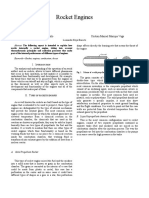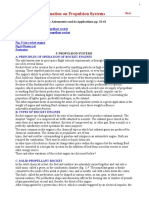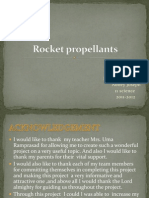0% found this document useful (0 votes)
33 views3 pagesRocket Propulsion System
The document discusses rocket propulsion systems. It describes the four main components of a rocket, including the propulsion system. The propulsion system produces thrust by accelerating and ejecting hot exhaust gases from the combustion of fuel and oxidizer in the rocket engine. There are two main types of rocket engines - liquid rockets, which pump liquid fuel and oxidizer components into the combustion chamber, and solid rockets, which have solid fuel packed into a cylinder. The amount of thrust produced depends on the mass and velocity of exhaust gases ejected from the rocket nozzle.
Uploaded by
Jal ThakkarCopyright
© © All Rights Reserved
We take content rights seriously. If you suspect this is your content, claim it here.
Available Formats
Download as DOCX, PDF, TXT or read online on Scribd
0% found this document useful (0 votes)
33 views3 pagesRocket Propulsion System
The document discusses rocket propulsion systems. It describes the four main components of a rocket, including the propulsion system. The propulsion system produces thrust by accelerating and ejecting hot exhaust gases from the combustion of fuel and oxidizer in the rocket engine. There are two main types of rocket engines - liquid rockets, which pump liquid fuel and oxidizer components into the combustion chamber, and solid rockets, which have solid fuel packed into a cylinder. The amount of thrust produced depends on the mass and velocity of exhaust gases ejected from the rocket nozzle.
Uploaded by
Jal ThakkarCopyright
© © All Rights Reserved
We take content rights seriously. If you suspect this is your content, claim it here.
Available Formats
Download as DOCX, PDF, TXT or read online on Scribd
/ 3

















































